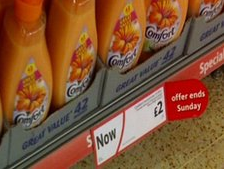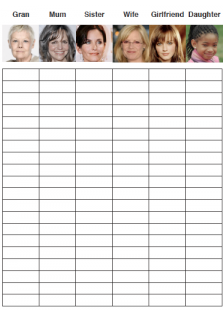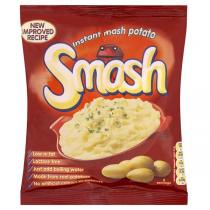While household budgets are under increasing pressure four of the top Uk supermarkets compete the title of the Uk's cheapest. Sainburys- offers to refund the difference on branded good s if they can be found cheaper elsewhere, Morrisons promotes its price crunch campaign while Asda guarantees to sell any goods 10% cheaper than it's rivals. Tesco pledge to slash the cost of every brand. Panorama investigates this further according to some customers these deals may sound to be good, but strip away all the jargon and promises of ' huge savings' it is just a tactile approach, which could lead to prosecution for the breach of customer regulation.
Retails analyst Richard Perks says, 'if there was a price war going on at the moment, we would have sees profits or we would have sever warnings and that is just not happening. Using the marketing budget as effectively as possible, to be as cheap as possible in how you promote using discount.
A Peers family get the same items every week and have discovered Tesco even though they are promoting their price drop campaign in September, their Price drop items are actually going up and are actually dearer than earlier in the year, for example a packed of Tescos unsalted butter has gone up 12p From originally being 98p earlier on in the year to now becoming £1.10. Tesco states that is has slashed the price of 1300 of it's products, but in reality this is only a mealy 10% of products they have in their stores. In result of this the loyalty club card scheme to help fund the price cuts has been slashed, when customers would receive 2 club card points for every item they buy, it is now resulting to 1. Anytime you do get a good deal they are compensating this by charging the customer for, for something else.
The advertising standard found that 3 of the top leading supermarkets, have been misleading customers customers throughout the years, they have banned 3 adverts from Morrisons, 10 from Asda and a disturbing 16 from Tescos
For example Tesco has an Advert stating that they were they sold 1.8 million baskets were cheaper at Tesco and compared to Asda - link of the advert shown below
This was discovered from the Advertising standard authority that the add only implied 218 thousand products and they didn't even include all the products in them
The WOW Factor
 At Asda the special offers online shopping site were offering WOW deals, saying they were items that were cheaper than they would normally be if purchased online.
At Asda the special offers online shopping site were offering WOW deals, saying they were items that were cheaper than they would normally be if purchased online.
The WOW Factor
 At Asda the special offers online shopping site were offering WOW deals, saying they were items that were cheaper than they would normally be if purchased online.
At Asda the special offers online shopping site were offering WOW deals, saying they were items that were cheaper than they would normally be if purchased online.When checking the history of some of the WOW items it was found that 11 of these items had been on sale at the same price for about 6 months, and four items were actually more expensive then they used to be. Not much to be saved by this.
Deboarah Harry - A lawyer who advised the Government on Eu consumer protection, regulations and British Law stated the WOW labelling they Asda are promoting could in fact be a breach of the LAw
"Your average consumer when they learned the truth that the price was not reduced and in fact had been increased almost certainly would not purchase them."
AWhen Panorma contacted them, Asda said that these product should not have been advertised as WOW products and removed them from their website.
This is advertising on the shelf that announced that you can purchase two for these products for £2, but in reality there is no saving there as the product is £1 per item, and dosen't highlight that there isn't a saving there.
This is a very clever way that can make some people buy more!!
Physcologist Gorkan Ahmetoglu wrote a report on the office for fair trading on the influence of promotional tools and offers of savings that Supermarkets use and what effect these have on the customers shopping habits. He mentions this type of Advertising acts as a Subconscious trigger.
"They are triggering the same reaction as when you eat chocolate. The offer will still attract your attention and a lot of people will not look at the single unit price."
Price Establishing
When price establishing the supermarket tells us 'slashed the price' of some items
A reatiler that sells a product at a certain price at a certain time, then sudden realises that Later the price has dropped back to where is was in the first place.
When the BBc anaylised this Tesco's big Price drop seemed to do this often with products such as medium whole fresh chickens, feature promonrnty in it's adds. It rose from £4 to £5 over two months and for the Big price drop it dropped back down to £4.
This method id completely legal as long as the higher price is left in place and established for 28 days or it is in line with cosumer expectation, this may be a problem and may get into trouble with the regulations.
Deborah Harry mentions that this could be a breach of the laws that put in plays to protect customers.
"If it could be established that the average consumer was being misled by the suggestion of a previous higher price... then it could lead to a criminal prosecution."
Tesco says that the pricing practice had breached no rules of and defended the price rises before the big price drop, saying it price was launched in a period food significant higher food costs a that the Pice Drop campaign was to helping to combat inflation, not illuminate it.
Less is More
At Asda a 1kg tub of butter £3.20 advertised to be a bigger pack and better value, but this seemed to be 20p more than buying 2 550g tubs of the same product.
At Tesco the Vanish stain remover was £12 for the 'big value' size, £3 more than if you just bough 3 smaller containers, which would make up to be the exact same content of the product.
This is when 'bigger pack, better value' in fact means 'bigger pack, but costs more'!
No scales

The fruit and vegetables is priced per kilo and some packaged items are often only priced per pack, with no wight listed. Only way was to weight the pack, then do some maths and people simply don't have time.
Sainburys sold five bannanas in a pack for £1, but bought loose for the same number they cost only 42p.
At Asda it was three red onions in a net sold for £2.85, when as bought loosely for the same number it cost just 86p.
AT Morrisons, it was the other way around - a pack of empire apples cost £1.82, where as bought loosely it would cost £2.99.
John Bridegman, the former head of office and fair trade training says supermarkets have the responsibility to be straight to their customers.
"We've got to do much better at giving people the information they need to buy carefully, properly and secure value."
All supermarkets told the BBc that customers like to have an option to buy by weight or pre packed.
Buy NOW!!
A labelled price in Morrisons says Now £2, but fails to state what the price was before. It states offer ends Sunday, but fails to mention that it cost only £1.65 before.
Morrisons said in their defence, that the product had been more expensive earlier in the year, so £2 was still representing good value for money.
This is a very clever way that can make some people buy more!!
Physcologist Gorkan Ahmetoglu wrote a report on the office for fair trading on the influence of promotional tools and offers of savings that Supermarkets use and what effect these have on the customers shopping habits. He mentions this type of Advertising acts as a Subconscious trigger.
"They are triggering the same reaction as when you eat chocolate. The offer will still attract your attention and a lot of people will not look at the single unit price."
Price Establishing
When price establishing the supermarket tells us 'slashed the price' of some items
A reatiler that sells a product at a certain price at a certain time, then sudden realises that Later the price has dropped back to where is was in the first place.
When the BBc anaylised this Tesco's big Price drop seemed to do this often with products such as medium whole fresh chickens, feature promonrnty in it's adds. It rose from £4 to £5 over two months and for the Big price drop it dropped back down to £4.
This method id completely legal as long as the higher price is left in place and established for 28 days or it is in line with cosumer expectation, this may be a problem and may get into trouble with the regulations.
Deborah Harry mentions that this could be a breach of the laws that put in plays to protect customers.
"If it could be established that the average consumer was being misled by the suggestion of a previous higher price... then it could lead to a criminal prosecution."
Tesco says that the pricing practice had breached no rules of and defended the price rises before the big price drop, saying it price was launched in a period food significant higher food costs a that the Pice Drop campaign was to helping to combat inflation, not illuminate it.
Less is More
At Asda a 1kg tub of butter £3.20 advertised to be a bigger pack and better value, but this seemed to be 20p more than buying 2 550g tubs of the same product.
At Tesco the Vanish stain remover was £12 for the 'big value' size, £3 more than if you just bough 3 smaller containers, which would make up to be the exact same content of the product.
This is when 'bigger pack, better value' in fact means 'bigger pack, but costs more'!
No scales

The fruit and vegetables is priced per kilo and some packaged items are often only priced per pack, with no wight listed. Only way was to weight the pack, then do some maths and people simply don't have time.
Sainburys sold five bannanas in a pack for £1, but bought loose for the same number they cost only 42p.
At Asda it was three red onions in a net sold for £2.85, when as bought loosely for the same number it cost just 86p.
AT Morrisons, it was the other way around - a pack of empire apples cost £1.82, where as bought loosely it would cost £2.99.
John Bridegman, the former head of office and fair trade training says supermarkets have the responsibility to be straight to their customers.
"We've got to do much better at giving people the information they need to buy carefully, properly and secure value."
All supermarkets told the BBc that customers like to have an option to buy by weight or pre packed.
Buy NOW!!
A labelled price in Morrisons says Now £2, but fails to state what the price was before. It states offer ends Sunday, but fails to mention that it cost only £1.65 before.
Morrisons said in their defence, that the product had been more expensive earlier in the year, so £2 was still representing good value for money.









































